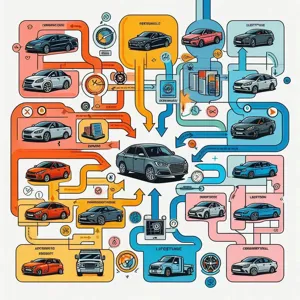Finding the perfect car that aligns with both your lifestyle and budget can often feel like navigating a complex maze filled with endless options and decisions.
With so many makes, models, and features available, it’s easy to become overwhelmed or feel uncertain about your choices. Whether you’re a busy parent needing ample space and safety features, a city dweller seeking compact efficiency, or an adventure enthusiast looking for rugged capability, your vehicle should reflect your unique needs and aspirations. In this ultimate guide, we’ll equip you with essential tips and insights to help you not only identify the right car for your lifestyle but also ensure that it fits comfortably within your financial parameters. From understanding your priorities and exploring financing options to evaluating essential features and conducting thorough test drives, we’ll take you step-by-step through the car-buying journey, empowering you to make an informed decision that you’ll be happy with for years to come. Let’s hit the road to your next great purchase!
1. Assessing Your Lifestyle Needs

When it comes to choosing the right car, the first step is to take a close look at your lifestyle needs. This critical evaluation will serve as the foundation for every decision you make throughout the purchasing process. Begin by asking yourself essential questions: Do you have a growing family that requires ample space for car seats and strollers? Are you frequently commuting long distances or navigating urban streets? Or perhaps you’re an adventure enthusiast who needs a vehicle capable of tackling rugged terrains?
Consider the daily demands of your life. If you spend a significant amount of time on the road, fuel efficiency and comfort should be high on your priority list. Opting for a hybrid or electric vehicle might be the ideal solution for minimizing fuel costs and environmental impact. On the other hand, if you’re often transporting large loads—whether it’s sports equipment, gardening supplies, or moving boxes—then a spacious SUV or a sturdy pickup truck may better suit your needs.
Moreover, reflect on your lifestyle preferences. Do you appreciate the luxury of a smooth ride or the thrill of a sporty performance? Are you someone who values cutting-edge technology and modern conveniences, or do you prefer a more straightforward, no-frills driving experience? Each of these factors will influence not only your enjoyment of the car but also its overall suitability for your day-to-day life.
Finally, it’s crucial to consider future changes. Life is dynamic, and your needs may evolve over time. If you anticipate changes such as a growing family or a new job that requires longer commutes, factor these potential shifts into your decision. By thoughtfully assessing your lifestyle needs, you will be better equipped to choose a vehicle that not only fits your current situation but will also continue to serve you well in the years to come.
2. Setting a Realistic Budget
Setting a realistic budget is a crucial step in the car-buying process that can help you avoid financial strain and ensure a smooth ownership experience. Begin by assessing your current financial situation: take a close look at your income, monthly expenses, and existing debts. This will help you determine how much you can comfortably allocate toward a car payment without jeopardizing your other financial obligations.
When establishing your budget, it’s important to account for more than just the sticker price of the vehicle. Be sure to include additional costs such as sales tax, registration fees, insurance premiums, and routine maintenance expenses. A good rule of thumb is to aim for a total monthly car-related expense that doesn’t exceed 15% of your take-home pay. This way, you can maintain a healthy balance between your transportation needs and your overall financial health.
Consider the type of financing you will use as well. If you plan to take out a loan, shop around for the best interest rates and loan terms, as these can greatly impact your total cost in the long run. Additionally, think about whether you prefer to lease or buy; leasing often comes with lower monthly payments but may limit your mileage and customization options.
Finally, remember to leave some wiggle room in your budget for unexpected expenses or opportunities that may arise after your purchase. Setting a realistic budget is not just about crunching numbers; it’s about creating a sustainable plan that aligns with your lifestyle and financial goals. By taking the time to thoughtfully assess your budget, you’ll feel more confident and empowered as you navigate your next car purchase.
3. New vs. Used: Which is Right for You?

When it comes to purchasing a car, one of the most significant decisions you’ll face is whether to buy new or used. Each option has its own set of advantages and considerations, and the right choice often depends on your lifestyle, budget, and personal preferences.
Buying a **new car** offers the allure of the latest technology, safety features, and warranties. You’ll have the peace of mind that comes with knowing your vehicle has no prior wear and tear. For those who prioritize reliability and want the latest advancements—such as better fuel efficiency or cutting-edge infotainment systems—a new car might be the way to go. Additionally, new cars typically come with generous warranties that can save you money on repairs and maintenance for the first few years of ownership.
On the flip side, **used cars** can provide significant savings, allowing you to get more vehicle for your money. The depreciation that new cars face the moment they leave the lot means that you can often find a quality used vehicle that is just a few years old at a fraction of the original cost. This option is particularly appealing for budget-conscious buyers or those who want to avoid the steep initial depreciation associated with new cars. Plus, the variety in the used car market means you can discover models that are no longer in production or find a unique gem that perfectly fits your style.
However, when considering used cars, it’s crucial to conduct thorough research. Look for vehicles with reliable histories, and consider getting a pre-purchase inspection to avoid potential pitfalls.
Ultimately, the decision between new and used comes down to your individual needs. If you value the latest technology and reliability without the worry of potential issues, a new car may be the right choice. Conversely, if you’re looking to maximize your budget and are willing to do a little extra legwork, a used car could be the perfect fit. Take your time to weigh the pros and cons of each option, and you’ll be well on your way to making a purchase that aligns with both your lifestyle and financial goals.
4. Understanding Different Car Types (SUVs, Sedans, Hatchbacks, etc.)
When it comes to choosing the right car for your lifestyle and budget, understanding the various types of vehicles available is essential. Each category serves different needs, preferences, and driving experiences, making it crucial to align your choice with your daily activities and aspirations.
**SUVs (Sport Utility Vehicles)** are designed for versatility and space. They typically offer a higher driving position, increased ground clearance, and ample cargo capacity, making them ideal for families, outdoor enthusiasts, or anyone requiring extra room for activities like camping or road trips. With options ranging from compact to full-sized SUVs, you can find a model that fits your budget while providing comfort and capability for both city commuting and rugged adventures.
**Sedans**, on the other hand, are the embodiment of efficiency and style. Known for their streamlined design and fuel efficiency, sedans are perfect for those who prioritize cost-effective commuting without sacrificing comfort. With a variety of models available, from compact sedans to more luxurious options, they cater to a wide range of preferences. If you’re looking for a vehicle that excels in city driving with ease of parking and excellent fuel economy, a sedan may be your best bet.
**Hatchbacks** offer the best of both worlds, combining the compactness of a sedan with the practicality of an SUV. They feature a rear hatch door that provides easy access to the cargo area, making them perfect for urban dwellers who need extra space for groceries, sports equipment, or luggage without the bulk of a larger vehicle. Hatchbacks are often more affordable and fuel-efficient, making them an appealing choice for budget-conscious buyers.
**Coupes** and **Convertibles** add a dash of sportiness to your driving experience. Coupes, with their two-door design and sleek lines, appeal to those who appreciate style and performance over practicality. Convertibles allow you to enjoy the open air and sunshine, perfect for leisurely drives or summer road trips. However, these options typically come with less cargo space and may not be as family-friendly, so consider your lifestyle before making a decision.
Finally, **Trucks** are built for heavy-duty performance. Whether you need to tow equipment, haul materials, or simply want a rugged vehicle for off-road excursions, trucks offer unmatched capabilities. With configurations ranging from compact to full-sized models, they can accommodate a variety of needs, but it’s essential to factor in fuel costs and maneuverability, especially in urban settings.
By understanding these different car types, you can better evaluate your lifestyle and budget, ensuring you make an informed decision that meets your needs and enhances your driving experience. Whether you prioritize space, efficiency, or performance, there’s a car out there that’s perfect for you.
5. Fuel Efficiency: Why It Matters

When it comes to choosing the right car for your lifestyle and budget, fuel efficiency should be at the forefront of your decision-making process. In today’s world, where environmental concerns and rising fuel prices are ever-present, understanding the significance of fuel efficiency can save you money and contribute to a sustainable future.
Fuel efficiency is not just about the number of miles you can drive per gallon of gas; it reflects the overall cost of ownership and impacts your daily driving experience. A vehicle with high fuel efficiency means fewer stops at the gas station, allowing you to allocate those savings towards other essential aspects of your life, whether it’s enjoying more family outings or investing in a cozy home. For commuters, the difference between a car that gets 20 miles per gallon and one that achieves 30 miles per gallon can add up significantly over time, reducing the strain on your wallet.
Moreover, fuel-efficient vehicles often have a smaller carbon footprint, making them a more environmentally friendly choice. As climate change remains a pressing issue, opting for a car that requires less fuel can be a conscious step toward reducing your impact on the planet. Many manufacturers now offer hybrid and electric options that not only enhance fuel economy but also provide innovative technology and features designed to make your driving experience more enjoyable.
As you weigh your options, consider how your driving habits align with the fuel efficiency ratings of potential cars. Do you frequently embark on long road trips, or is your daily routine composed mainly of short city commutes? Understanding your specific needs will help you choose a vehicle that not only suits your lifestyle but also maximizes your fuel efficiency, ensuring you get the most bang for your buck.
In summary, fuel efficiency matters—both for your financial health and for the health of the planet. By prioritizing this aspect during your car-buying journey, you can make an informed decision that aligns with your values and enhances your overall driving experience.
6. Researching Safety Ratings and Features
When it comes to purchasing a vehicle, safety should always be a top priority. Ensuring that your next car is equipped with the latest safety ratings and features can make a significant difference in protecting you and your loved ones on the road. Before diving into the vast pool of options, it’s essential to understand how to effectively research and evaluate the safety credentials of potential vehicles.
Start by exploring reliable resources such as the National Highway Traffic Safety Administration (NHTSA) and the Insurance Institute for Highway Safety (IIHS). These organizations conduct rigorous crash tests and assessments, providing safety ratings that help consumers make informed decisions. Look for vehicles with high ratings in categories like frontal crash tests, side-impact tests, and rollover resistance. A good rule of thumb is to prioritize cars that have received a five-star overall safety rating, as they have demonstrated superior performance in various crash scenarios.
In addition to ratings, delve into the specific safety features offered by each vehicle. Modern cars come equipped with an array of advanced safety technologies designed to help prevent accidents and protect occupants in the event of a collision. Features such as adaptive cruise control, lane departure warning, blind-spot monitoring, and automatic emergency braking can significantly enhance your driving experience. Make a checklist of must-have safety features that align with your lifestyle—if you often drive in busy urban areas, for instance, features that assist with parking and collision avoidance may be particularly beneficial.
Don’t overlook the importance of reading customer reviews and expert opinions, as they can provide insights into real-world performance and reliability. Pay attention to feedback regarding the car’s safety systems—do they function as intended, and are they easy to use? Consider reaching out to forums or social media groups dedicated to car enthusiasts, where you can pose questions and gather firsthand experiences from current owners.
By thoroughly researching safety ratings and features, you can confidently narrow down your options and choose a vehicle that not only meets your lifestyle needs but also ensures peace of mind on the road. In a world where safety is paramount, taking the time to evaluate these aspects will ultimately lead you to a car that you can trust for years to come.
7. Evaluating Reliability and Maintenance Costs

When it comes to choosing the right car, evaluating reliability and maintenance costs is a critical step that often gets overlooked. After all, the excitement of a shiny new vehicle can sometimes overshadow the practical considerations of its long-term performance and upkeep. However, understanding these factors can save you significant time, money, and frustration down the road.
Start by researching the reliability ratings of the models you’re considering. Websites like Consumer Reports and J.D. Power provide comprehensive reviews and rankings based on real owner feedback. Look for vehicles that consistently score high in reliability; these are often the ones that will require fewer repairs and less frequent visits to the mechanic. Brands known for their durability, such as Toyota and Honda, often top these lists, reflecting a commitment to quality engineering that can stand the test of time.
Next, consider the average maintenance costs associated with each make and model. Some vehicles are more expensive to maintain due to the cost of parts, specialized service requirements, or simply because they have more complex systems that are prone to issues. For instance, luxury vehicles might have higher maintenance costs due to the premium parts and services required, while certain compact cars may offer lower maintenance expenses. Tools like RepairPal can help you estimate the cost of ownership over time, allowing you to make a more informed decision.
It’s also wise to factor in the warranty coverage offered by manufacturers. A robust warranty can provide peace of mind, potentially covering the costs of repairs and maintenance for a number of years. Look for vehicles that come with comprehensive warranties, as they often reflect the manufacturer’s confidence in their product’s reliability.
Lastly, don’t forget to consider the availability of local mechanics who are familiar with the specific car model. A car that requires a specialized technician for repairs might be less convenient and more costly than one that can be serviced by a wide range of local garages.
By thoroughly evaluating reliability and maintenance costs, you’ll be better equipped to choose a car that not only fits your lifestyle but also aligns with your budget for years to come. This foresight can lead to a more satisfying ownership experience, allowing you to focus on enjoying the ride rather than worrying about unexpected expenses.
8. Test Driving: What to Look For
When it comes to test driving a car, the experience is about so much more than simply taking it for a spin around the block. It’s your opportunity to assess how well the vehicle aligns with your lifestyle and budget, so you’ll want to approach it with a discerning eye and a checklist of considerations.
First and foremost, pay attention to the vehicle’s comfort. Adjust the seats to find your ideal driving position, and take note of how supportive they feel during your drive. Is there ample legroom for both the driver and passengers? Test the headroom, especially if you often transport taller friends or family. If you have kids, make sure the back seat is spacious enough for car seats or booster seats.
Next, consider the vehicle’s visibility. Check how easy it is to see out of the front, sides, and rear. Take note of the blind spots, and adjust the mirrors to ensure you have a clear view of surrounding traffic. This is especially crucial for larger vehicles like SUVs and trucks, which can have more significant blind spots.
As you drive, pay attention to the handling and responsiveness of the car. Is it easy to maneuver, both in tight spaces and at higher speeds? Listen for any unusual noises, such as rattles or squeaks, which could indicate underlying issues. Test the brakes to ensure they feel responsive and secure, and assess how the suspension handles bumps and rough roads—this can greatly affect your comfort during long drives.
Don’t overlook the technology features either. Familiarize yourself with the infotainment system, including how intuitive it is to operate. Can you easily connect your smartphone? Are the controls user-friendly and within reach? Features like adaptive cruise control, lane-keeping assist, and parking sensors can significantly enhance your driving experience, so take the time to test these out.
Lastly, consider how the car fits into your budget. While the purchase price is crucial, also evaluate the fuel efficiency, insurance costs, and potential maintenance expenses. A vehicle that fits within your monthly budget but does not meet your lifestyle needs may lead to dissatisfaction down the road.
In essence, a test drive is your chance to really “live” with a vehicle before making a commitment. Use this time to ask yourself the tough questions about how well the car meets your daily needs, and trust your instincts. After all, the right car should feel like an extension of your lifestyle, not just a mode of transportation.
9. Comparing Financing Options
When it comes to purchasing a vehicle, understanding your financing options is crucial to making an informed decision that aligns with both your lifestyle and budget. With a multitude of choices available, it can be overwhelming to determine the best route to take. Here, we break down the main financing avenues to consider, ensuring you choose a plan that suits your needs.
**1. Traditional Auto Loans:** These are typically offered by banks, credit unions, and online lenders. They allow you to borrow a specific amount for a set term, usually between three to seven years. Interest rates can vary based on your credit score and the lender, so it’s wise to shop around for the best deal. Traditional loans can be a great option if you have a solid credit history and prefer to own your car outright once the loan is paid off.
**2. Dealership Financing:** Many dealerships offer financing options directly through their own networks or third-party lenders. While this can be convenient, it’s essential to read the fine print. The interest rates may not always be competitive, and sometimes dealerships may push for longer loan terms that can lead to higher overall costs. Always compare dealership offers with other financing options to ensure you’re getting the best possible deal.
**3. Leasing:** If you’re someone who enjoys driving a new car every few years, leasing could be an attractive option. With leasing, you pay for the vehicle’s depreciation during the lease term, rather than the full purchase price. This often results in lower monthly payments compared to traditional financing. However, it’s important to consider mileage limits and potential fees for excessive wear and tear, which can add up over time.
**4. Personal Loans:** If you prefer not to go through traditional auto financing or leasing, a personal loan can also be utilized to purchase your vehicle. This option gives you the flexibility to buy a car from any source, not just dealerships. However, personal loans may come with higher interest rates than auto loans, so it’s critical to calculate the total cost before proceeding.
**5. Cash Purchase:** If you have the means, buying a car outright with cash is the most straightforward option. This eliminates monthly payments and interest altogether, allowing you to own your vehicle immediately. However, it’s still important to ensure that purchasing a car in cash won’t deplete your savings or emergency funds.
As you explore these financing options, take the time to calculate your overall budget, including insurance, maintenance, and fuel costs. Understanding how each payment structure will impact your finances in the long run is key to making a choice that supports your lifestyle and economic goals. Whether you’re opting for a loan, lease, or cash purchase, being informed will empower you to navigate your next car purchase with confidence.
10. The Importance of Vehicle History Reports for Used Cars
When it comes to buying a used car, one of the most critical steps you can take is to obtain a vehicle history report. This comprehensive document serves as a window into the car’s past, offering valuable insights that can significantly influence your purchasing decision. Think of it as the car’s autobiography—revealing its previous owners, accident history, service records, and even mileage discrepancies.
A vehicle history report typically includes details such as whether the car has been in any major accidents, if it has a salvage title, or if it has ever been reported as stolen. Armed with this information, you can make a more informed decision and avoid potential pitfalls. For instance, a vehicle that has been involved in a serious collision may have hidden damage that could lead to costly repairs down the line. Similarly, a car with a history of frequent ownership changes might indicate underlying issues that you’d want to steer clear of.
Additionally, these reports often provide details about any recalls that may have been issued for the vehicle, ensuring that you’re aware of any safety concerns. Understanding the car’s service history can also give you insights into how well it has been maintained. A vehicle that has been regularly serviced is likely to be more reliable than one that has been neglected.
In today’s digital age, obtaining a vehicle history report is easier than ever. Websites such as Carfax and AutoCheck allow you to enter the Vehicle Identification Number (VIN) and receive a detailed report in just a few minutes. While there may be a small fee for this service, the peace of mind it provides is invaluable. Ultimately, investing in a vehicle history report can save you from unexpected expenses and ensure that your next used car purchase aligns with both your lifestyle and your budget. Don’t skip this essential step; it could be the difference between a wise investment and a costly mistake.
11. Negotiating the Best Price
Negotiating the best price for a car can be one of the most daunting aspects of the purchasing process, but it doesn’t have to be. With the right approach and preparation, you can feel confident and empowered to secure a deal that aligns with both your budget and your lifestyle.
Start by doing your homework: research the make and model you’re interested in, paying close attention to market prices, dealership incentives, and financing options. Websites like Kelley Blue Book and Edmunds can provide valuable insights into fair pricing, helping you establish a solid baseline for negotiations. Knowing the car’s market value not only strengthens your position but also signals to the dealer that you are an informed buyer.
Once you have your facts straight, it’s time to approach the negotiation table. Always enter the dealership with a clear idea of your budget but be flexible enough to explore different options. When discussing price, begin with a number that is slightly lower than your target to allow room for counteroffers. Remember, the goal is to create a win-win situation. Use any additional information you gathered—like competitor pricing or current promotions—to bolster your case.
Don’t shy away from walking away if the deal doesn’t meet your expectations. Often, this can prompt the salesperson to present a better offer, especially if they see a potential sale slipping away. Lastly, remain patient and courteous throughout the process; establishing a rapport can often lead to more favorable terms.
By preparing thoroughly and engaging in the negotiation process with confidence and respect, you can secure a car that not only fits your lifestyle and budget but also leaves you feeling satisfied with your purchase. After all, buying a car is not just a transaction; it’s an investment in your future mobility.
12. Understanding Warranties and After-Sales Service
When it comes to purchasing a vehicle, understanding warranties and after-sales service can be just as crucial as choosing the right model or negotiating the best price. A warranty serves as a safety net, providing peace of mind that your investment is protected against unexpected repairs and defects. But not all warranties are created equal, and navigating the fine print can be overwhelming.
Start by distinguishing between the different types of warranties offered: the manufacturer’s warranty typically covers defects in materials and workmanship for a set period, while extended warranties, often available for purchase at the dealership, can provide additional coverage for mechanical failures after the original warranty expires. Pay close attention to what is included in these warranties—some may cover only specific components, while others may offer more comprehensive protection.
After-sales service is equally vital in your car ownership experience. A reputable dealership will not only provide a reliable warranty but also have a robust service department that can assist with regular maintenance and repairs. It’s worth researching the dealership’s customer service ratings and reviews to ensure you will receive quality care after the sale. Moreover, consider the convenience of service locations; a dealership close to home can save you time and hassle in the long run.
Additionally, familiarize yourself with the terms and conditions of your warranty. Knowing your rights and responsibilities can prevent misunderstandings later on, especially regarding routine maintenance and the use of third-party service providers. Some warranties may require you to have your vehicle serviced exclusively by the dealership to remain valid, while others may allow flexibility.
Ultimately, understanding warranties and after-sales service can enhance your ownership experience, ensuring that you’re not only satisfied with your purchase but also well-supported throughout your vehicle’s life. Take the time to ask questions and clarify any doubts with the dealership before signing on the dotted line; your future self will thank you for being informed and proactive.
13. The Role of Technology in Modern Cars
In today’s automotive landscape, technology plays a pivotal role in shaping not only the driving experience but also the overall functionality of modern vehicles. As you navigate your next car purchase, it’s essential to consider how the latest advancements can enhance your lifestyle and fit within your budget.
From advanced infotainment systems that seamlessly integrate with your smartphone to driver-assistance features that elevate safety, technology has transformed cars into sophisticated machines that cater to a variety of needs. For instance, features like adaptive cruise control, lane-keeping assist, and automatic emergency braking can significantly reduce the stress of driving in congested traffic or on long road trips, making them invaluable for busy professionals or families.
Moreover, electric and hybrid vehicles are now equipped with smart technology that maximizes efficiency and minimizes environmental impact. With options for regenerative braking and energy management systems, these cars not only save you money on fuel but also contribute to a more sustainable future.
When evaluating your choices, take the time to explore the technology packages offered by different manufacturers. Some cars come with cutting-edge connectivity options, such as built-in Wi-Fi hotspots and voice-activated navigation, perfect for tech-savvy individuals. Others may have features tailored for families, like rear-seat entertainment systems and advanced safety technology that keeps your little ones secure.
Ultimately, the role of technology in modern cars extends beyond mere convenience; it enhances your driving experience, aligns with your values, and meets the specific demands of your lifestyle. As you assess your options, don’t hesitate to test drive vehicles equipped with the latest tech. This hands-on approach will help you gauge how these features can seamlessly integrate into your daily routine, ensuring you choose a car that not only fits your budget but also enriches your life on the road.
14. Preparing for Trade-Ins or Selling Your Old Car
When it comes to upgrading your vehicle, preparing for trade-ins or selling your old car is a crucial step that can significantly impact your budget for your next purchase. The process might seem daunting, but a little preparation can go a long way in ensuring you get the best value for your old ride.
Start by assessing the condition of your car. A thorough cleaning—both inside and out—can make a remarkable difference. Consider detailing the interior, washing and waxing the exterior, and addressing any minor repairs. A well-maintained vehicle not only looks more appealing but also instills confidence in potential buyers or dealers about its reliability.
Next, it’s essential to gather all necessary documentation. This includes the title, maintenance records, and any warranties that may still be in effect. Having this paperwork organized and readily available can expedite the selling process and help justify your asking price.
Research the current market value of your car using resources like Kelley Blue Book or Edmunds. These platforms provide valuable insights into how much similar vehicles are selling for in your area. This knowledge will empower you during negotiations, whether you’re trading in at a dealership or selling privately.
If you’re considering trading your car in, don’t hesitate to shop around. Visit multiple dealerships to get appraisals, as offers can vary significantly. Keep in mind that dealerships often account for their margins when making offers, so a lower trade-in value might be expected compared to a private sale. However, the convenience of a trade-in can sometimes outweigh the potential for a higher price.
For those opting to sell privately, be prepared to handle inquiries and test drives. Transparency about your vehicle’s history and condition can foster trust with potential buyers. Additionally, consider listing your car on multiple platforms to maximize visibility and reach the right audience.
By taking these steps to prepare for your trade-in or sale, you’ll not only make the process smoother but also increase your chances of securing a fair return on your investment. With the right preparation, you can turn your old car into a valuable asset that helps fund your next vehicle purchase, making the transition to your next automotive adventure that much easier.
15. Final Checklist Before Making Your Purchase
Before you finalize your car purchase, it’s essential to conduct a thorough final checklist to ensure that you’ve covered all bases and made an informed decision. This last-minute evaluation can save you from buyer’s remorse and help you feel confident about your choice.
**1. Budget Review:** Start by revisiting your budget. Confirm that the total cost, including taxes, fees, and any additional expenses like insurance, fits comfortably within your financial plan. Remember to consider the long-term costs of ownership, such as fuel efficiency and maintenance.
**2. Vehicle Inspection:** If you’re buying a used car, a comprehensive inspection is a must. Check the exterior and interior for any signs of wear and tear, rust, or damage. Don’t forget to pop the hood and look at the engine. If you’re unsure, consider hiring a trusted mechanic to assess the vehicle’s condition.
**3. Test Drive:** A test drive is crucial. It’s not just about how the car looks; it’s about how it feels. Pay attention to the comfort of the seats, the visibility, and the overall driving experience. Test it in various scenarios—urban streets, highways, and perhaps even rougher terrains if that’s relevant to your lifestyle.
**4. Research Vehicle History:** For used cars, obtain a vehicle history report using the VIN (Vehicle Identification Number). This report can reveal critical information about previous accidents, repairs, and ownership history.
**5. Review Financing Options:** If you are financing your purchase, compare rates from different lenders. Don’t just settle for the first offer; shop around for better interest rates that could save you money over the life of the loan.
**6. Negotiate the Price:** Don’t hesitate to negotiate. Research similar vehicles to understand the market price and come prepared with this information to discuss with the seller. A little negotiation can lead to significant savings.
**7. Consider Warranties and Service Plans:** Check if the car comes with warranties or if you want to purchase an extended warranty for added peace of mind. Understand what is covered and for how long, as this can be a valuable safety net.
**8. Final Paperwork Review:** Finally, before signing on the dotted line, read through all documents carefully. Ensure that all agreed-upon terms are clearly stated, including any promises made by the dealer. Don’t rush this step; it’s your right to understand every detail of the transaction.
By following this final checklist, you’ll be well-equipped to make a car purchase that aligns with your lifestyle and budget. Taking the time to ensure every aspect is covered not only enhances your buying experience but also sets you up for years of satisfaction with your new vehicle. Happy driving!
As you embark on the exciting journey of selecting your next vehicle, we hope this ultimate guide has equipped you with the essential tools and insights to make an informed decision that perfectly aligns with your lifestyle and budget. From evaluating your needs and exploring financing options to considering long-term costs and test-driving potential candidates, each step is crucial in ensuring you find a car that not only meets your practical requirements but also brings joy to your daily drives. Remember, the right car is more than just a means of transportation; it’s an investment in your life’s adventures. So take your time, weigh your options, and trust your instincts as you navigate your next purchase. Happy car hunting, and may you find the perfect ride that complements your journey ahead!




















